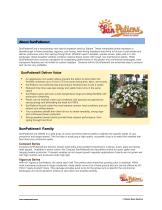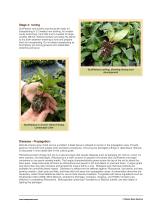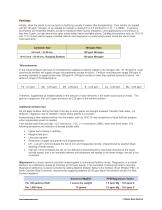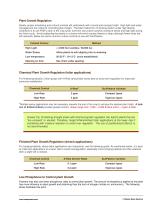
Catalog excerpts

SunPatiens® Culture Guide © Sakata Seed America
Open the catalog to page 1
About SunPatiens® SunPatiens® are a revolutionary new hybrid impatiens bred by Sakata. These remarkable plants represent a breakthrough in flower breeding: vigorous, sun–loving, heat–loving impatiens that thrive in full sun or part shade and deliver continuous color from spring through frost. Whether used in baskets, window boxes, patio pots or in the landscape, these beautiful varieties combine massive flower power with tough, low-maintenance plants. While SunPatiens® have a proven reputation for outstanding performance in the garden and commercial landscapes, their impressive features are...
Open the catalog to page 2
SunPatiens Culture Guide Propagation Rooting Material Select a sterile, porous and well-aerated material for optimum rooting. Good aeration is important for preventing soft rots such as Pythium and Rhizoctonia and allows for more controlled growth during the later stages of propagation. Foam, peat, rockwool and media blends with 3040% aggregate are all good choices. Because SunPatiens develop strong root systems quickly, direct sticking into the final container is a common practice. For direct stick production, use similar misting and light levels as outlined below for rooting liners....
Open the catalog to page 3
Stage 2: Root Emergence Once roots start to emerge, raise the light level to 3,000-3,500 foot candles/32,000-38,000 lux to speed development and prevent stretching. Target a day and night temperature of 68°F/20°C with a two-hour morning temperature drop, (5-7°F/2-3°C) beginning at dawn. Maintaining as close to a 0° DIF (difference between the day and night temperature) as possible with morning temperature drop reduces stretching and promotes compact cuttings. When roots form, apply 75 ppm nitrogen from a well-balanced calcium nitrate-based formulation to strengthen the plants and enable...
Open the catalog to page 4
Stage 4: toning SunPatiens root quickly and should be ready for transplanting in 2-3 weeks from sticking, for smaller cavity sized trays (144/128) and 3-4 weeks for large cavities (98/72). Reduce fertilizer and allow the plants to dry down between watering to tone and prepare them for transplanting. Do not delay transplanting as SunPatiens are strong growers and undesirable stretching will occur. SunPatiens cutting, showing strong root development SunPatiens in 3-inch/ 70mm Fertiss Landscape Liner Diseases - Propagation: Botrytis cinerea (gray mold) can be a problem if dead tissue is...
Open the catalog to page 5
New Guinea Impatiens infected with Rhizoctonia Pythium irregulare is a water mold that may also attack SunPatiens through the roots or cutting wound. Symptoms of Rhizoctonia and Pythium look similar. If there is an obvious black stem, with wide or narrow black stripes, then Pythium is the most likely cause. Please note that black discoloration further up the stem may be an indication INSV (Impatiens Necrotic Spot Virus). Another obvious sign of Pythium infection is a black discoloration of the vascular tissue inside a cut stem, (easily seen by looking at the stem base). This discoloration...
Open the catalog to page 6
Transplanting Media SunPatiens do best in a media that is well-aerated. High porosity mixes, such as those made from coarse/ long fiber peat moss or short fiber peat moss blended with 30-40% aggregate work very well. For containers that will not be retransplanted, such as hanging baskets or large patio pots, a media with higher water holding capacity is desirable for consumers. Optimum pH for SunPatiens is 5.8 to 6.2 with a starting EC less than 0.5 mmhos/cm (1:2) / 1.4 (SME). Avoid a pH below 5.8 which can induce iron and manganese toxicity. Containers SunPatiens work well in a wide range...
Open the catalog to page 7
Temperature Initially, maintain 65-70°F/18-21°C in the root zone to establish the crop. Then, once the plants are fully rooted and the canopy begins to fill in, the temperature may be lowered to 55-60°F/13-16°C to save energy or control growth. Maintain as close to a 0° DIF (little variance between day and night temperature) as possible with a 5-7°F/2-3°C temperature drop for 2 hours beginning at dawn to produce compact plants and limit internode stretch. SunPatiens perform well and set buds over a wide range of temperatures, from 55-85°F/13-29°C. Research by Dr. James Faust, (Clemson...
Open the catalog to page 8
Fertilizer Initially, allow the plants to root out prior to fertilizing (usually 2 weeks after transplanting). Then fertilize as needed with 65-100 ppm* nitrogen, or as needed to maintain a media EC of 0.5 mmhos/cm (1:2) / 1.4 (SME). In general, SunPatiens are moderate feeders, similar to traditional New Guinea Impatiens. Limit applications of ammonium to less than 5 ppm, as high ammonium rates cause softer tissue and taller stems. Cal/Mag formulations such as 15-5-15 and 17-5-15 work well to supply valuable calcium and magnesium in areas where water levels are low in these macroelements....
Open the catalog to page 9
Grower Tip: Although visual symptoms are helpful, periodic testing of the substrate by a certified lab is the best way to manage pH and plant nutrition. Potassium, Calcium and Magnesium Balance: A recommended ratio of Potassium, Calcium and Magnesium for SunPatiens is 4: 2: 1. Below is a chart outlining how to supply this ratio using single element fertilizers. Growers should target this balance based on an analysis of their irrigation water and substrate testing. *actual percentage of K as the bag lists the percentage as K2O, which is potassium oxide and not actual K **cannot be tank mixed...
Open the catalog to page 10
Plant Growth Regulation Ideally, proper scheduling and cultural controls will yield plants with a toned and compact habit. High light and water management are critical to controlling plant height. The best method for minimizing stretch under high density conditions is to use PGR’s early in the crop cycle, and then use culture controls (moisture stress and high light during the finish cycle. Avoid subjecting the plants to a severe wilt which causes flowers to drop (although flower buds are still retained). Below are some common culture controls to use with SunPatiens. Cultural Control High...
Open the catalog to page 11All Sakata Seed America Inc catalogs and technical brochures
-
PANSY AND VIOLA
6 Pages
-
OSAKA IQ ORNAMENTAL CABBAGE
2 Pages
-
CALIPETITE® CALIBRACHOA
4 Pages
-
VIKING® BEGONIA
6 Pages
-
MAJORETTE GERBERA
4 Pages
-
CUT FLOWER CATALOG 2024/2025
32 Pages
-
NEW VARIETIES 2024 & 2025
18 Pages
-
ORNAMENTALS CATALOG 2023 & 2024
106 Pages
-
SUNDANCE™ LANTANA
2 Pages
-
2022-23 New Varieties
16 Pages











